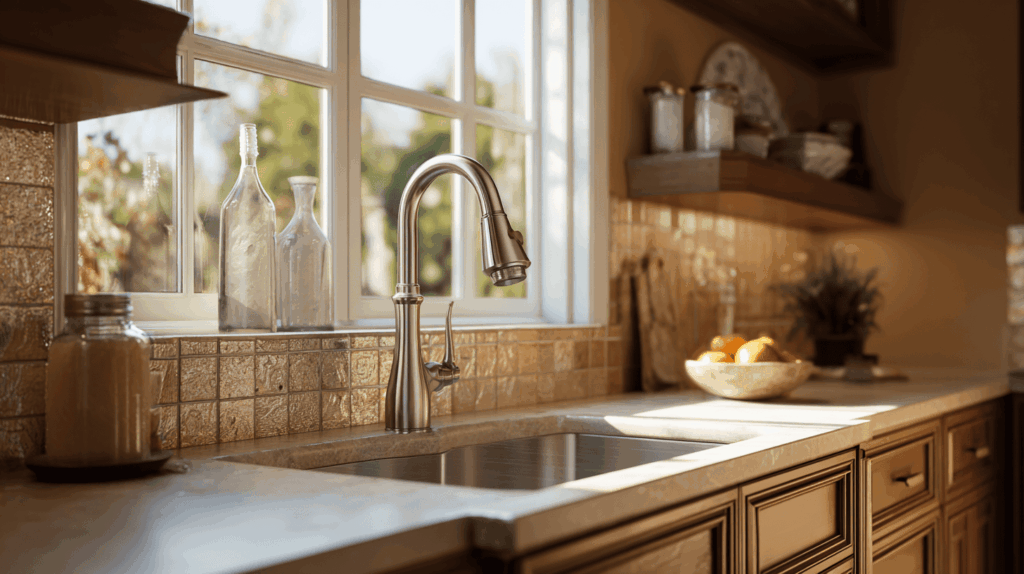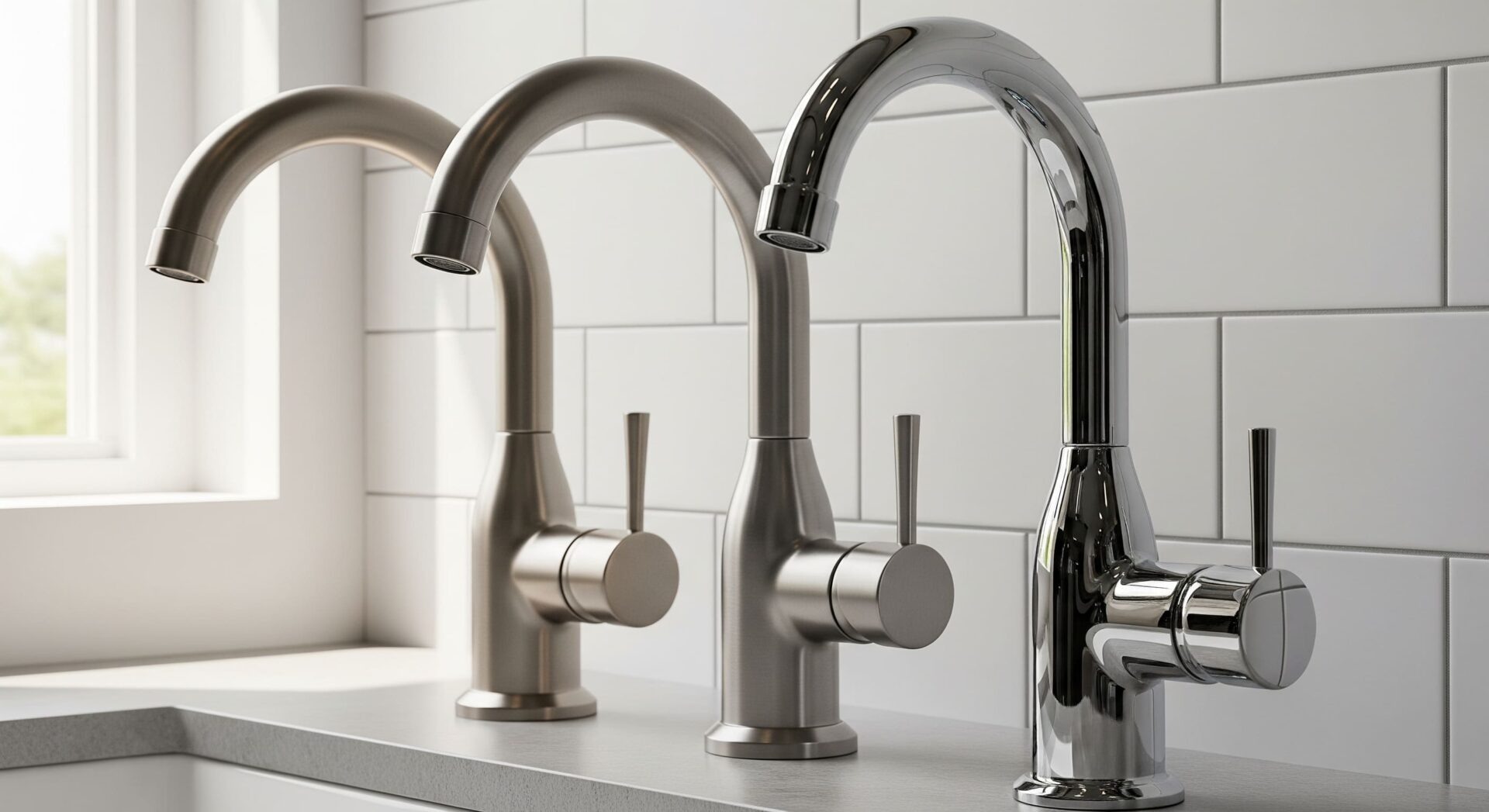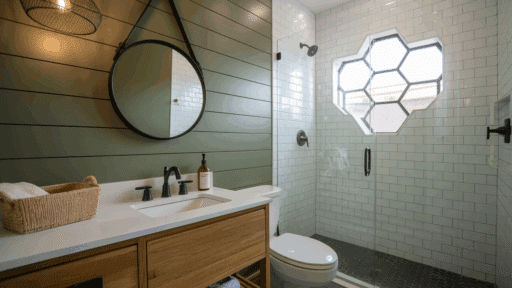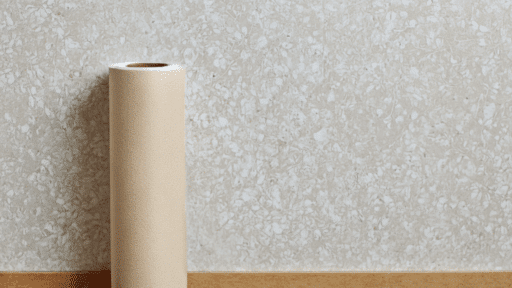We get it, picking between brushed nickel, stainless steel, and chrome can feel overwhelming.
They all look kind of similar at first, but each one behaves differently when it comes to style, cleaning, and how well it fits with your cabinets or appliances.
This guide will make your choice a whole lot easier. We’ll break things down clearly so you know what to expect from each finish, not just how it looks, but how it works in real kitchens and bathrooms.
You’ll see side-by-side comparisons, pros and cons, expert tips, and real-life use cases. If you’re remodeling or just replacing a faucet, this guide will help you pick the finish that fits your space and lifestyle.
How to Know Which Finish Belongs in Your Kitchen or Bathroom
Before we dive into comparisons, take a second to think about how you use your space.
Are you someone who cooks a lot and wants everything to match your stainless steel appliances? Or are you more about warmth, texture, and low maintenance?
Ask yourself:
- Do I want something that hides smudges and fingerprints?
- Do I prefer a shiny, modern look, or something softer and matte?
- Am I trying to match existing appliances, hardware, or tile?
These little details make a big difference. Once you know your priorities, picking between brushed nickel, stainless steel, or chrome becomes a whole lot easier.
Brushed Nickel vs. Stainless Steel: What’s the True Difference?
Although these two finishes may seem alike from afar, the details tell a different story. Here’s how they compare side by side:
| Feature | Brushed Nickel | Stainless Steel |
|---|---|---|
| Tone | Warm, muted gray with a softer look | Cool, silvery metallic that feels crisp and modern |
| Texture and Feel | Textured with visible brush strokes | Smooth and uniform with minimal grain |
| Reflectivity | Matte surface that reduces glare and hides fingerprints | Slight shine, less reflective than chrome, but still catches some light |
| Best Style Fit | Works well in traditional, rustic, or transitional kitchens | Great for modern, minimalist, or industrial spaces |
| Best Pairings | Warm-tone cabinets, beige backsplashes, cozy décor | White cabinetry, glass tile, stainless appliances |
| Appliance Match | It may look slightly off next to stainless appliances | Perfect match for stainless steel appliances |
| Fingerprint Resistance | Excellent, hides smudges and water spots well | Moderate is more likely to show fingerprints and light marks |
If you want warmth, texture, and low-maintenance style, go with brushed nickel. If durability, sleekness, and appliance-matching matter more, stainless steel is the smarter pick.
Brushed Nickel Pros and Cons for Kitchen Fixtures

Brushed nickel is one of the most popular hardware finishes and for good reason. Let’s look at the key benefits and a few drawbacks to help you decide if it’s the right fit for your kitchen or bathroom.
Benefits of Brushed Nickel
- Hides water spots and fingerprints, great for families
- Adds warmth to kitchens with wooden or beige cabinets
- Works with transitional, rustic, and even vintage styles
- Easy to maintain with a simple wipe-down
Drawbacks
- It may cost slightly more than stainless steel
- Doesn’t always match stainless appliances perfectly
Ideal Uses:
- Kitchen faucets
- Cabinet knobs and pulls
- Towel bars and light fixtures
- Bathroom vanities need a soft finish
Brushed nickel is a solid pick if you want something timeless that doesn’t show smudges easily.
Stainless Steel Pros and Cons for Kitchen Sinks and Hardware

Stainless steel is a go-to choice for modern kitchens, especially when durability and a clean look matter. Here’s a quick breakdown of its strengths and a few things to keep in mind before you decide.
Benefits of Stainless Steel
- Highly durable and resistant to rust or corrosion
- Matches appliances like ovens, dishwashers, and refrigerators
- Low-maintenance and long-lasting
- Widely available in various product lines
Drawbacks
- Can show scratches or water spots over time
- Feels cooler and may clash with warm design elements
Best Uses:
- Undermount and apron-front kitchen sinks
- Built-in soap dispensers and pull-out faucets
- Hardware in minimalist or industrial kitchens
If your kitchen already includes stainless appliances, this finish creates a seamless and unified look.
Comparing Brushed Nickel, Chrome, and Polished Nickel Finishes
When comparing finishes, it helps to see how chrome, brushed nickel, and polished nickel stack up side by side. Here’s a quick look at their tone, shine, upkeep, and best uses to guide your choice.
| Finish | Tone | Shine | Style Fit | Maintenance | Best Use Cases |
|---|---|---|---|---|---|
| Chrome | Cool | Very high | Modern, minimal | High | Sleek kitchens, glass-heavy bathrooms, high-contrast modern spaces |
| Brushed Nickel | Warm | Low | Traditional, rustic | Low | Transitional kitchens, laundry rooms, and spaces needing warmth and easy upkeep |
| Polished Nickel | Warm | High | Luxe, vintage-inspired | Moderate | Premium bathrooms, statement faucets, and kitchens with marble or gold accents |
Each finish offers its own look and lifestyle fit. If you’re after easy maintenance, sleek shine, or upscale warmth, this table helps you match the right metal to the right space.
How to Match Finishes with Cabinets, Sinks, and Appliances
To create a balanced look in your kitchen or bathroom, your hardware finishes must work well with other materials and colors in the space.
Brushed nickel pairs beautifully with brass, bronze, or black accents. Its warm tone works best with beige, cream, or natural wood cabinets. It’s a strong match for transitional or rustic design themes.
Stainless steel, on the other hand, blends naturally with silver, matte black, or glass finishes. Its cool tone complements white or gray cabinets and modern tile. It also syncs perfectly with stainless appliances, creating a seamless and unified appearance.
As a general rule, avoid using too many high-shine finishes together, especially in rooms with low lighting. Be sure to consider the finishes on light fixtures, sinks, and nearby appliances so everything feels intentional, not mismatched.
Maintenance Tips for Brushed Nickel, Stainless Steel, and Chrome
Each finish needs a different approach to stay clean and smudge-free. These quick tips will help you care for your kitchen and bathroom hardware the right way.
- Wipe brushed nickel with a soft cloth and mild soap; no scrubbing needed.
- Avoid using bleach or rough sponges that can scratch or dull the nickel finish.
- Use stainless steel spray with vinegar or a stainless cleaner for a streak-free shine.
- Avoid using steel wool or harsh pads that can leave permanent marks.
- Use a microfiber cloth and vinegar-water mixture to remove smudges and restore shine on Chrome.
With just a few minutes of gentle cleaning each week, your hardware will keep looking fresh, polished, and built to last, with no extra effort needed.
Pro Tip: Keep a dry cloth nearby, chrome shows fingerprints fast and benefits from regular touch-ups.
Wrapping it Up
Choosing the right finish really depends on your style and how much upkeep you’re okay with. If you want something warm and easy to care for, brushed nickel is a great pick, especially for cozy kitchens with wood cabinets or neutral tones.
If your space leans modern and your appliances are all stainless, then stainless steel gives you that clean, durable look that ties everything together.
Prefer a little extra shine? Chrome delivers that sleek, polished feel, though it may need more cleaning to stay smudge-free.
Still unsure between brushed nickel vs stainless steel? Start by updating your faucet. It’s often the centerpiece that helps set the tone for your entire kitchen or bathroom.








